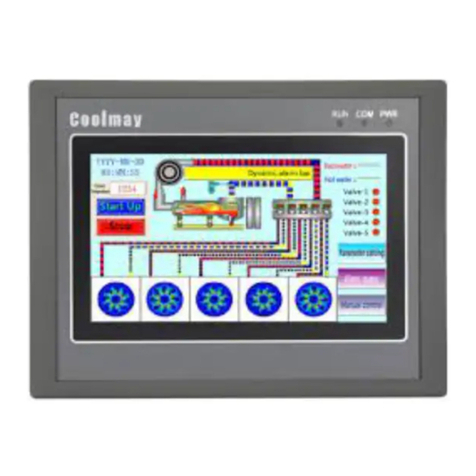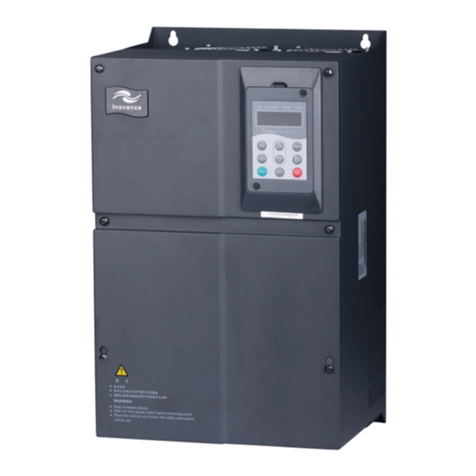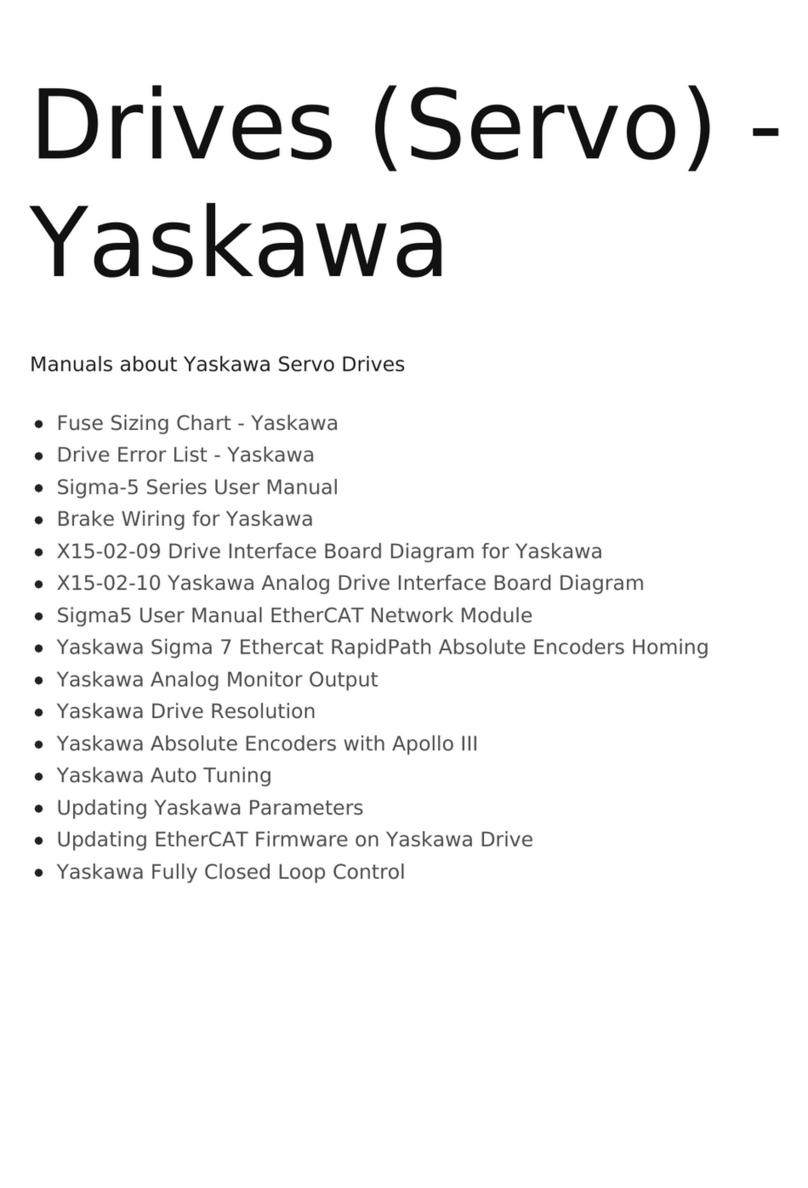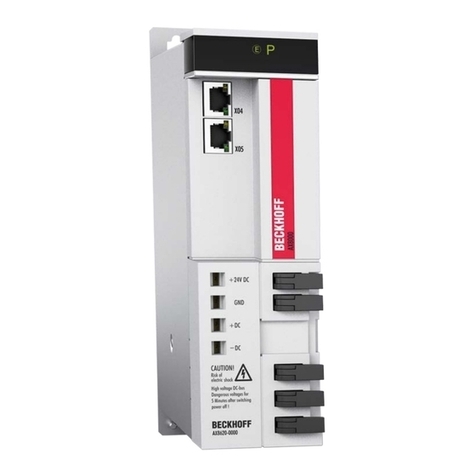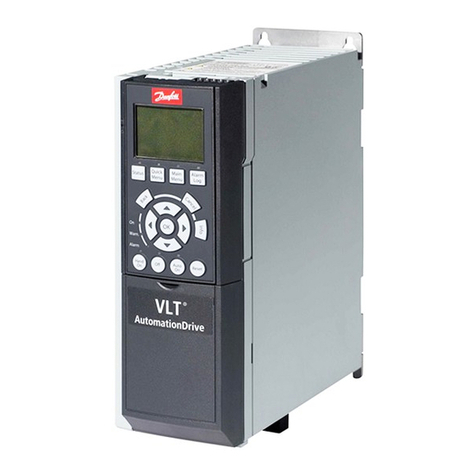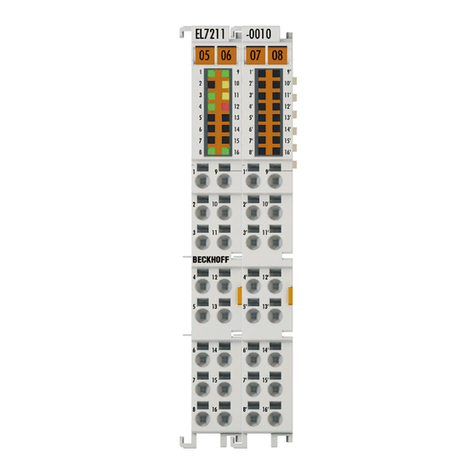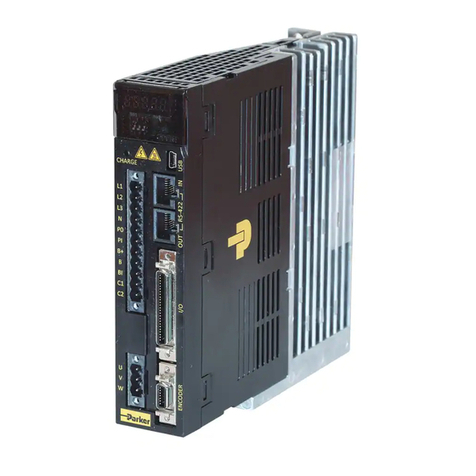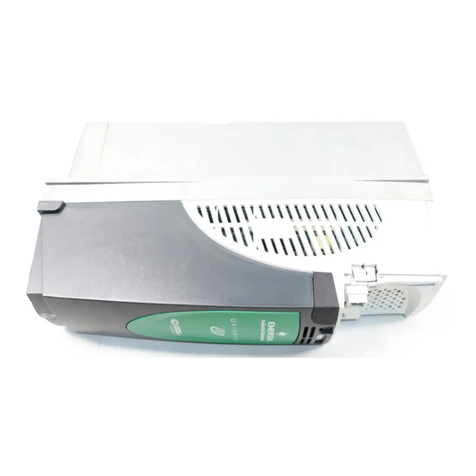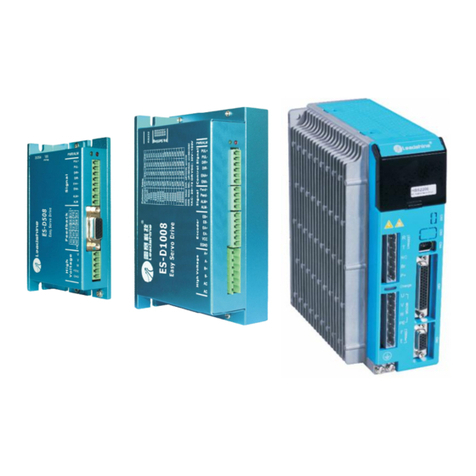Powtran ADSD-S-S Series User manual

Preface ADSD-S-S
1
Preface
Thank you very much for purchasing ADSD-S-S series servo products. This manual
provides related contents on how to use our ADSD-S-S servo drive and ADSM-S motor.
Before using the product, please read this user manual thoroughly to ensure correct use,
incorrect use may cause abnormal operation or shorten the service life, even directly damage
the product.
Please store this manual in a safe and handy place for quick reference whenever
necessary.
Safety information
WARNING indicates a dangerous situation that can result in death, serious physical injury or
equipment damage.
CAUTION indicates a potentially dangerous situation that might possibly result in bodily harm or
equipment damage. This is also available for safe operation of not guarding.
Safety precautions:
Carefully note and observe the following safety precautions when receiving, inspecting, installing,
operating, maintaining and troubleshooting.
Receiving inspecting
CAUTION
☆ In order to prevent fire hazard and accidents, please form the wiring by the
cable specifications outlined in this user manual.
Installation
As a hazardous voltage may remain inside the drive, electrical equipment should be installed and
inspected only by qualified personnel. Do not maintain the internal circuit before the capacitance
finishing discharging.
Preface ADSD-S-S
2
CAUTION
☆ Do not use the product in a wet location or where have corrosive and
inflammable gases or liquids. Failure to observe this caution may result in
electric shock, fire, or personal injury.
Wiring
WARNING
☆ The drive and motor’s grounding terminal should correctly connect to the
ground according country electrical safety requirements. Failure to observe
this caution may result in electric shock, fire, or personal injury.
CAUTION
☆ Do not connect any power supplies to the U, V, W terminals. Failure to
observe this precaution may result in serious injury, damage to the drive or
fire.
☆ Ensure that all screws, connectors and wire terminations are secure on the
power supply, servo drive and motor. Failure to observe this caution may
result in damage, fire or personal injury.
Operation
WARNING
☆ In order to prevent accidents, the initial trial run for servo motor should be
conducted under no load conditions (separate the motor from its couplings
and belts).
☆ Do not approach or touch any rotating parts (e.g. shaft) while the motor is
running. Failure to observe this precaution may cause serious personal
injury.
☆ Before starting the operation with a mechanical system connected, change
the drive parameters to match the user-defined parameters of the
mechanical system. Starting the operation without matching the correct
parameters may result in servo drive or motor damage, or damage to the
mechanical system.
☆ Ensure that the emergency stop equipment or device is connected and
working correctly before operating the motor that is connected to a
mechanical system.
☆ Do not touch either the drive heat sink during operation as they may
become hot and personal injury may result.
Maintenance and inspection
WARNING
☆ Do not touch any internal or exposed parts of servo drive and servo motor
as electrical shock may result.
☆ Do not remove the operation panel while the drive is connected to an
electrical power source otherwise electrical shock may result.

Preface ADSD-S-S
3
☆ Wait at least 5 minutes after power has been removed before touching any
drive or motor terminals as an electrical charge may still remain in the
servo drive and servo motor with hazardous voltages even after power has
been removed.
☆ Do not disassemble the servo drive or motor as electric shock may result,
otherwise electrical shock personal injury may result.
☆ Do not connect or disconnect wires or connectors while power is applied to
the drive and motor. Otherwise electrical shock personal injury may result.
Main circuit terminal wiring
CAUTION
☆ Do not install the motor power cables and encoder cables together, install
the encoder cables in a separate conduit from the motor power cables to
avoid signal noise. Separate the conduits by 30cm above.
☆ Use multi-stranded twisted-pair wires or multi-core shielded-pair wires
for signal, encoder (PG) feedback cables. The maximum length of
command input cable is 3m and the maximum length of encoder (PG)
feedback cables is 20m.
☆ As a charge may still remain in the drive with hazardous voltages even
after power has been removed, be sure to wait at least 5 minutes after
power has been removed before performing any wiring and/or inspection.
☆ It is not recommended to frequently power the drive on and off. Do not
turn the drive off and on more than once per minute as high charging
currents within the internal capacitors may cause damage(within 0.2
minutes).
Main circuit terminal wiring
CAUTION
☆ Insert only one wire into one terminal on the terminal block.
☆ When inserting wires, please ensure that the conductors are not shorted to
adjacent terminals or wires.
Servo motor perform trial run separately
CAUTION
☆ Please perform trial run without load first and then perform trial run with
load connected. After the servo motor is running normally and regularly
without load, then run servo motor with load connected. Ensure to perform
trial run in this order to prevent unnecessary danger.
Servo motor and mechanical system trial run in team
CAUTION
☆ In order to prevent accidents, the initial trial run for servo motor should be
conducted under no load conditions (separate the motor from its couplings
and belts), that mean, just let the motor work separately, do not operate the
servo motor while it is connected to its mechanical system, because
connecting the motor to its mechanical system may cause damage or result
Preface ADSD-S-S
4
in personal injury during the trail run.
It includes
1. Installation of AC servo drives and motors
2. Configuration and wiring
3. Trial run steps
4. Control functions and adjusting methods of servo drives
5. Parameter settings
6. Inspection and maintenance
7. Troubleshooting
8. Application examples
Who should use this manual?
1. Those who are responsible for designing.
2. Those who are responsible for installing or wiring.
3. Those who are responsible for operating or programming.
4. Those who are responsible for maintaining or troubleshooting.
If you have other questions, Please consult our distributors or our customer services center.
A&D customer services center telephone: +086 0411-84753201 to 611 or 612
+086 400 0411755

Contents ADSD-S-S
5
Contents
Chapter 1 Unpacking check and model explanation...................................................................... 8
1-1 Unpacking check .................................................................................................................. 8
1-2 Model explanation ................................................................................................................ 9
1-2-1 Servo drive nameplate explanation............................................................................ 9
1-2-2 Servo motor nameplate explanation........................................................................... 9
1-2-3 Servo drive and servo motor combinations.............................................................. 10
1-3 Parts of the servo controller name....................................................................................... 11
Chapter 2 Installation..................................................................................................................... 12
2-1 Safety and precautions ........................................................................................................ 12
2-2 Storage conditions............................................................................................................... 12
2-3 Installation conditions......................................................................................................... 12
2-4 Installation procedure and minimum clearances ................................................................. 13
Chapter 3 Connections and wiring................................................................................................15
3-1 Peripheral devices connect with main circuit...................................................................... 15
3-1-1 Peripheral devices connection ................................................................................. 15
3-1-2 Control circuit terminals .......................................................................................... 16
3-1-3 Using wire specifications......................................................................................... 17
3-1-4 Power supply connections for control circuit........................................................ 17
3-2 CN1 Input / Output Interface .............................................................................................. 18
3-3 CN2 encoder signal connections......................................................................................... 20
3-4 Interface circuit................................................................................................................... 20
3-4-1 Input switching interface ......................................................................................... 20
3-4-2 Output switching interface....................................................................................... 21
3-4-3 Position pulse instructions ....................................................................................... 22
3-4-4 The motor encoder signals output............................................................................ 23
3-4-5 The motor encoder signals Z signal open-collector output. ..................................... 24
3-4-6 Input / output digital signal interface definition....................................................... 25
3-5 Standard connection mode.................................................................................................. 27
3-6 Motor wiring....................................................................................................................... 28
3-7 Wiring note ......................................................................................................................... 28
Chapter 4 Panel and the keyboard display and operation........................................................... 29
4-1 Panel display and operation ................................................................................................ 29
4-1-1 Parts of the panel ..................................................................................................... 29
4-1-2 Numerical display.................................................................................................... 29
Contents ADSD-S-S
6
4-1-3 Parameter setting description................................................................................... 30
4-2 Main menu.......................................................................................................................... 30
4-3 State monitoring.................................................................................................................. 30
4-4 Parameter setting ................................................................................................................ 33
4-5 Parameter management....................................................................................................... 34
4-6 Auxiliary function............................................................................................................... 36
4-6-1 Special function ....................................................................................................... 36
4-6-2 JOG function ........................................................................................................... 36
4-6-3 Keyboard speed ....................................................................................................... 36
4-6-4 Analogue adjustable zero......................................................................................... 36
4-7 Parameters the default recovery.......................................................................................... 37
Chapter 5 Commissioning operation............................................................................................. 38
5-1 Inspection without load....................................................................................................... 38
5-1-1 Wiring and checking................................................................................................ 38
5-1-2 JOG trial operation .................................................................................................. 38
5-1-3 Keyboard speed operation ....................................................................................... 39
5-2 Position control mode ......................................................................................................... 40
5-2-1 Wiring diagram........................................................................................................ 40
5-2-2 Parameter setting ..................................................................................................... 41
5-2-3 Instructions pulse transmission path ........................................................................ 42
5-2-4 Instructions pulse input methods ............................................................................. 42
5-2-5 Pulse sequence of instructions specification............................................................ 43
5-2-6 Signal filtering ......................................................................................................... 44
5-2-7 Smoothing filtering.................................................................................................. 44
5-2-8 Input electronic gear ................................................................................................ 45
5-2-9 The position control the gain ................................................................................... 49
5-2-10 Gain adjustment..................................................................................................... 49
5-2-11 Resonance inhibit .................................................................................................. 52
5-2-12 Over travel protection............................................................................................ 53
5-2-13 Torque limitation ................................................................................................... 53
5-2-14 Work timing........................................................................................................... 54
5-2-15 Electromagnetic brake ........................................................................................... 55
Chapter 6 Parameter function description ................................................................................... 57
6-1 Parameter table ................................................................................................................... 57
6-1-1 0 Period of parameters............................................................................................. 57
6-1-2 1 Period of parameters............................................................................................. 65

Contents ADSD-S-S
7
6-2 DI function table ................................................................................................................. 68
6-3 DO function table................................................................................................................ 70
Chapter7 Alarm.............................................................................................................................. 71
7-1 Alarm messages table ......................................................................................................... 71
7-2 Causes and treatment of the alarm ...................................................................................... 72
Chapter 8 Maintenance and inspection......................................................................................... 78
8-1 Basic inspection .................................................................................................................. 78
8-2 Maintenance........................................................................................................................ 79
8-3 Lifespan of servo drive components ................................................................................... 79
Chapter 9 Specification .................................................................................................................. 80
9-1 Specifications of servo drive...............................................................................................80
9-2 Standard specification of servo motor................................................................................. 81
9-3 Dimensions of servo drive .................................................................................................. 85
9-4 Dimensions of servo motor................................................................................................. 86
9-5 Braking resistance meter..................................................................................................... 90
9-6 Drive motor adapter table ...................................................................................................91
Chapter 10 Application examples.................................................................................................. 92
10-1 ADSD-S drive and numerical control system ................................................................... 92
10-1-1 The electrical schematic diagram with HNC-21T.................................................. 92
10-1-2 The schematic chart of matching with Guangzhou NC GSK218M. ...................... 93
10-1-3 The schematic chart of matching with KND NC KOS. ......................................... 94
10-2 A&D servo drive matching with Delta DVP12SC11T2 PLC ........................................... 95
Appendix................................................................................................................................... 96
Addendum Drive matched cable ............................................................................................... 96
Chapter 1 Unpacking Check and Model Explanation ADSD-S-S
8
Chapter 1 Unpacking check and model explanation
Do not install or run any damage or malfunction of the servo drive, or they may result in personal
injury or damage to the equipment.
1-1 Unpacking check
Please check the following items after purchase, to prevent negligence in the process of procurement
and transportation of products:
Check item Description
Ensure that the product is what
you have ordered.
Please refer to the direction on the brand of the controller and
the model explanation of the following
Ensure that the servo motor
shaft rotates freely.
Rotate the motor shaft by hand; a smooth rotation will indicate a
good motor. However, a servo motor with an electromagnetic
brake can not be rotated manually.
Checking for damage. Visual inspect the unit to insure it was not damaged during
shipment.
Checking for loose screws. Visual inspect if there are screws loose or loosen off.
Ensure that directions and
warranty card in the packing
container
Read the instructions carefully, operate is according to the
instructions
If any problem mentioned above happened, please inform the distributor whom you purchased the
product from or our company.
A complete and workable AC servo system should include the following parts:
(1) Servo drive and Servo motor.
(2) One power cable, which is used to connect servo motor and U, V, W terminals of servo drive.
This power cable is with one green grounding cable. Please connect the green grounding cable to
the ground terminal of the servo drive.
(3) One encoder cable, which is used to connect the encoder of servo motor and CN2 terminal of
servo drive.
(4) Connector CN1: 26 Pin
(5) Connector CN2: 15 Pin

Chapter 1 Unpacking Check and Model Explanation ADSD-S-S
9
1-2 Model explanation
1-2-1 Servo drive nameplate explanation
AD SD - S 2 3 - 20 S
Simple series
Module current crest value
15:15A 20:20A 30:30A
1:1-phase
3:3-phase
Voltage: 220V
Company: A&D
Servo drive
S: AC synchronous
1-2-2 Servo motor nameplate explanation
AD SM - S 110 - 040 M 20 D K Z M
Company: A&D
Servo motor
S:AC synchronous
Flange size
60:60mm 80:80mm
130:130mm
Rated torque
020:2N.m 040:4N.m
077:7.7N.m 100:10N.m
150:15N.m
Series
M:M series
C:C series
Break
Z: with break
dafault:without
Shaft type:
K: with key
dafault:without
Encoder
D:Incremental encoder 2500ppr
T:Incremental encoder 2500ppr
Rated speed
15:1500rpm 20:2000rpm
25:2500rpm 30:3000rpm
Motor inertia
L:Low M:Middle
Chapter 1 Unpacking Check and Model Explanation ADSD-S-S
10
1-2-3 Servo drive and servo motor combinations
Motor Parameter Servo
d
rive model
Motor Code
[*] Motor Model
Rated
Torque
(N.m)
Rated
Speed
(rpm)
Rated
Power
(kW)
15S 20S 30S
S60-006M30 0.6 3000 0.2 ●
S60-013M30 1.3 3000 0.4 ●
S60-019M30 1.9 3000 0.6 ●
S80-013M30 1.3 3000 0.4 ●
S80-024M30 2.4 3000 0.75 ●
S80-035M20 3.5 2000 0.73 ●
S80-040M25 4 2500 1.0 ●●●
S90-024M30 2.4 3000 0.75 ●●●
S90-035M20 3.5 2000 0.73 ●●●
S90-040M25 4 2500 1.0 ●●●
B101
S110-020M30 2 3000 0.6 ●
B101 S110-040M20 4 2000 0.8 ●●
B102 S110-040M30 4 3000 1.2 ●●
B103 S110-050M30 5 3000 1.5 ●●
B102 S110-060M20 6 2000 1.2 ●●
B104 S110-060M30 6 3000 1.6 ●●
B301 S130-040M25 4 2500 1.0 ●●
B303 S130-050M25 5 2500 1.3 ●●
B304 S130-060M25 6 2500 1.5 ●●
B306 S130-077M25 7.7 2500 2.0
●
B302 S130-100M10 10 1000 1.0 ●●
B308 S130-100M15 10 1500 1.5 ●●
B309 S130-100M25 10 2500 2.6 ●
B310 S130-150M15 15 1500 2.3 ●
● indicated can match use
*: Motor code was set by the drive parameter L002.

Chapter 1 Unpacking Check and Model Explanation ADSD-S-S
11
1-3 Parts of the servo controller name
CN1
CN2
L1 L2 R STUVW
RB RB1 E
Main power lamp
Heatsink socket
Fasten the control and for
heat dissipation
Numerical display, display
monitor value,parameter
values, parameter values
Run lamp
Controller connector
Consistent with
programmable controller
or control I/O
Encoder connector
Consistent with servo encoder
Control circuit input terminals
L1 and L2 offer 1-phase 220V
50/60Hz VAC supply.
Main circuit output terminals
Ensure the voltage class of supply
power consistent with the rated
voltage of servo drive, if the
voltage class of supply power out of
range will damage the control.
Internal and external braking
resistance connected terminals .
Note:if internal braking resistance
can't meet the demand, parallel in
the terminals of RB and RB1 with
corresponding resistance .
Down key
Up key
Ground terminal
Exit key
Confirmed key
Operating space
Main circuit input terminals
R,S,T offer 220V 50/60Hz
VAC supply.
Chapter 2 Installation ADSD-S-S
12
Chapter 2 Installation
2-1 Safety and precautions
Please pay close attention to the following installation notes:
1)The personnel without qualified training, who works at servo driver devices/system or not abides
by relevant provisions of the "warning", may cause serious personal injury and property damage .
Only the person who was trained and was qualified after the authenticated about the equipment, such
as the design, installation, commissioning and operating, could be allowed to operate the equipment.
2) Do not bend or strain the connection cables between servo drive and motor.
3) When mounting servo drive, make sure to tighten screws to secure the drive in place.
4) If the servo motor shaft is coupled directly to a rotating device ensure that the alignment
specifications of the servo motor, coupling, and device are followed.
5) If the length of cable connected between servo drive and motor is more than 20m, please increase
the wire gauge of the encoder cable and motor connection cable (connected to U, V, W
terminals).
6) Make sure to tighten the screws for securing motor.
2-2 Storage conditions
The product should be kept in the shipping carton before installation. In order to retain the
warranty coverage, the servo drive should be stored properly when it is not to be used for an
extended period of time. Some storage suggestions are:
●Store in a clean and dry location free from direct sunlight.
●Store within an ambient temperature range of -20°C to +65°C.
●Store within a relative humidity range of 0% to 90% and non-condensing.
●Do not store in a place subjected to corrosive gases and liquids.
●Correctly packaged and placed on shelf or table.
2-3 Installation conditions
The ambient temperature of servo drive for long-term reliability should be within under
0 ~55 .℃℃If the ambient temperature of servo drive is greater than 45°C, please install the drive in a
well-ventilated location and do not obstruct the airflow for the cooling fan. The servo drive and
motor will generate heat. If they are installed in a control panel, please ensure sufficient space
around the units for heat dissipation. Pay particular attention to vibration of the units and check if the
vibration has impacted the electric devices in the control panel. What’s more, please observe the
following precautions when selecting a mounting location:
●The location without heat-radiating elements or high temperature;
●The location without dropping water, steam, dust or oil.
●The location without inflammable or combustible or explosive gas or liquid;
●The location without airborne dust or metallic particles.

Chapter 2 Installation ADSD-S-S
13
●The location without vibration and shock.
●The location without high levels of electromagnetic radiation.
The ambient temperature of servo drive for long-term reliability should be within under -20 ~55 .℃℃
Install the product in a clean and dry location
1. When assembling control cabinet, avoiding the metal scraps dropping into servo driver
2. Keep dropping water , steam , dust or oil away from control cabinet and the fun of servo
drive.
3. If set the control panel at a place with corrosive gases or dust, should forced ventilation (into
control cabinet clean air, make the internal pressure is higher than the external pressure) to
prevent these material into the control cabinet.
2-4 Installation procedure and minimum clearances
Important Attentions:
Installation direction must be in accordance with the provisions, incorrect installation may
result in a drive malfunction. In order to ensure the drive is well ventilated, ensure that the all
ventilation holes are not obstructed and sufficient free space is given to the servo drive. Ac servo
drive when the installation, the air intake and exhaust vent can not be sealed, nor a horizontal
position, otherwise it will cause failure.
Installation Procedure:
In order to help the cooling fan subject to a lower wind block so as to dissipate the heat more
effectively, we suggest users to observe below minimum installation clearance.
Minimum Clearances:
Chapter 2 Installation ADSD-S-S
14
50mm(min)
50mm(min)
20mm(min) 20mm(min)
100mm(min)
100mm(min)
20mm(min) 10mm(min) 10mm(min) 10mm(min)
100mm(min)
100mm(min)
40mm(min)
FUN FUN

Chapter 3 Connections and Wiring ADSD-S-S
15
Chapter 3 Connections and wiring
Servo drive power use three-phase AC 220 V, general, that was gained from three-phase AC 380 V
through the transformer. Specially, less than 1 KW motor could use single-phase 220V
(Single-phase power is connected to any 2 terminals of R, S, T).
3-1 Peripheral devices connect with main circuit.
3-1-1 Peripheral devices connection
M
Power
1-phase220V
3-phase220V
Magnetic
Contactor
Servo Motor
Power Supply
Encoder
Upper Computer
(CNC PLC)
Servo Motor
PE
Brake
Resistor
(inscribed)
CN1
CN2
L1 L2 R STUVW
RB RB1 PE
Chapter 3 Connections and Wiring ADSD-S-S
16
1. Check if the wiring of control circuit power (L1, L2) and main circuit power (R, S, T) are
correct.
2. Ensure the voltage class of supply power consistent with the rated voltage of servo drive, if
the voltage class of supply power out of range will damage the product.
3. Check the U, V, W cable is properly connected.
4. Ensure that the drive and motor are correctly connected to a ground.
5. Braking resistance is internal connected to RB and RB1,usually does not need to link
external braking resistance, if internal braking resistance can't meet the demand, parallel in
the RB, RB1 terminals with corresponding resistance .
6. If a fault or emergency stop occurs, using ALARM digital output can control
electromagnetic contactor and cut off the power of the servo drive.
7. Ensure that all necessary screws are tight and secure.
3-1-2 Control circuit terminals
Terminal
Identification
Terminal
description Functions
L1,L2 Control circuit
input terminals
The servo Control circuit requires an independent 220V
single-phase VAC supply.
R,S,T Main circuit input
terminals
The Main Circuit Terminal is used to supply the servo
with line power. If a single-phase supply, is used
connect the R and S terminals to power. If 3-phase,
connect all three R, S, & T terminals. To provide
Control Circuit power two jumpers can be added from R
and S to L1 and L2.
U,V,W Servo motor
output connect to motor power input terminal
RB,RB1
Braking
resistance
terminals
Using internal brake
PE Ground terminal Motor ground
CN1 Control interface Used to connect controller
CN2 Encoder
connector Used to connect servo motor encoder.
Wiring connection should pay close attention to follows:
1) As a residual hazardous voltage may remain inside the drive, please do not immediately touch any
of the "power" terminals (R, S, T, U, V, & W) and the cables connected to them after the power has
been turned off and the charge LED is light.

Chapter 3 Connections and Wiring ADSD-S-S
17
2) The cables connected to R, S, T and U, V, W terminals should be placed in separate conduits from
the encoder or other signal cables. Separate them as far as possible more than 30 cm interval.
3) If the encoder cable is need to lengthen, please use a twisted-shield signal wire with grounding
conductor. The wire length should be 20m or less. For lengths greater than 20m, the wire gauge
should be doubled in order to lessen any signal attenuation.
3-1-3 Using wire specifications
Connect terminal Servo drive model and cables
specifications
Connect
terminal Label Connector
description (15S) (20S) (30S)
L1、L2
Control
power
terminal
1mm2
AWG18
1mm2
AWG18
1mm2
AWG18
R,S,T Main power
terminal
1mm2
AWG18
1mm2
AWG18
1.5mm2
AWG16
U,V,W Motor power
terminal
1mm2
AWG18
1mm2
AWG18
1.5mm2
AWG16
Terminal
block
(TB)
PE Ground
terminal
1mm2
AWG18
1mm2
AWG18
1.5mm2
AWG16
CN1
Connector 1~26 pin
Control
instruction
interface
0.2mm² shielded twisted-pair
cables
CN2
Connector 1~15 pin Encoder
interface
0.2mm² shielded twisted-pair
cables
3-1-4 Power supply connections for control circuit
Servo drives wiring connections include single phase connection and three phase connection.
Single phase connection can only fit for 1KW following models. In below drawing, 1MC/x is
electromagnetic contactor coil, 1MC/ a is self-holding power, 1MC is main circuit interface.
Three-phase power supply connection method(fit for unit whose module power crest value
1KW or above).
Chapter 3 Connections and Wiring ADSD-S-S
18
Single-phase power supply connection method(fit for unit whose module power crest value is
under 1KW)
3-2 CN1 Input / Output Interface
CN1 I/O Interface signal description (Illustration shows arrangement of the plug welding feet)
1
10
19

Chapter 3 Connections and Wiring ADSD-S-S
19
General signal
Signal code Pin
No. Function Interface
DI1 1
DI2 10
DI3 19
DI4 20
DI5 21
DI7 6
Photoelectric isolated input ,the
functional is programmable, defined by
parameters L100 ~ L104 .
Digital
Signal
Input
COM+ 22
DI power supply (DC12V~24V)
C1
DO1 11
DO2 2
DO3 3
Photoelectric isolated output,maximum
output power ,50mA/25V,functional
programmable, defined by parameters
L130 ~ L132.
Digital
Signal
Output DOCO
M 12 Digital signal output common
C2
PULS+ 13
PULS- 4
SIGN+ 14
Position
Pulse
Instructions SIGN- 5
The high-speed photoelectric isolated
input, set to work mode by L035
parameters: Pulse and symbol;
Positive or negative pulse;
Orthogonal pulse.
C3
OA+ 9
OA- 18
OB+ 23
OB- 15
0Z+ 17
OZ- 16
Dividing the encoder signals and
outputting it through the differential
driver (Line Driver).
C5
CZ 26 Z signal open collector output
The Motor
Encoder
Signals
output
GND 24 The motor encoder signals ground C6
Plug
gold -
Shielding
Wire
Protected Metal
shell -
Connected shielding wire of shielded
cable -
Digital signal input
Signal Signal code Pin No. Function
DI1 1 Digital input 1.
DI2 10 Digital input 2.
DI3 19 Digital input 3.
DI4 20 Digital input 4.
DI5 21 Digital input 5.
DI
DI7 6 Digital input 7.
Chapter 3 Connections and Wiring ADSD-S-S
20
Digital signal output
Signal Signal code Pin No. Function
DO1 11 Digital output 1
DO2 2 Digital output 2
DO
DO3 3 Digital output 3
3-3 CN2 encoder signal connections
CN2 interface signal description
6
11
1
Signal
Identifi
cation
Pin No function
A+ 5 Encoder A +phase input
A- 10 Encoder A - phase input
B+ 4 Encoder B +phase input
B- 9 Encoder B- phase input
Z+ 3 Encoder Z +phase input
Z- 8 Encoder Z - phase input
U+ 2 Encoder U +phase input
U- 7 Encoder U - phase input
V+ 1 Encoder V +phase input
V- 6 Encoder V - phase input
W+ 12 Encoder W - phase input
W- 11 Encoder W - phase input
+5V 13 Encoder using 5V power
GND 14 Encoder using 5V ground
PE 15 Shielded
3-4 Interface circuit
3-4-1 Input switching interface
1.Digital signal input identification
Digital input interface circuit can be controlled by switch, relay, open collector triode,
photoelectric coupler etc. Relay required to choose low current relay, in order to avoid causing bad
contact phenomenon. External voltage range from DC12V to 24V.
C1-1: Input switching

Chapter 3 Connections and Wiring ADSD-S-S
21
4.7K
DI1
DI2
4.7K
COM+
DC12V-24V
Servo drive
C1-2: Open collector triode
4.7K
DI1
DI2
4.7K
COM+
DC12V-24V
Servo drive
0V
3-4-2 Output switching interface
Output switching interface (C2)
The output circuit adopts Darlington photoelectric coupler, and connects with relays and
photoelectric coupler. Safety information:
※ Power supply by users, If the power supply is wrong connection, can lead to drive damage.
※ The external power supply is biggest 25 V, output maximum current is 50 mA , 3 road total
current no more than 100 mA.
※ When using inductive load such as relays, need to join diode and inductive load in parallel, if
the reverse polarity diode that can lead to drive damage.
※ Turn on, about 1 V pressure drop, can't meet the TTL low level requirements, so can't connect
with TTL circuit directly.
Chapter 3 Connections and Wiring ADSD-S-S
22
C2-1: Relay
DOCOM
DO1
DC12V-24V
Servo drive
0V
Relay
The largest output50mA
★Freewheeling diode must be plus
DOCOM
DO1
DC12V-24V
Servo drive
0V
The largest output 50mA
C2-2 : Photoelectric coupler
3-4-3 Position pulse instructions
Position pulse instructions (C3)
There are two connection ways of differential drive and single-ended drive, recommend
difference drive method. To wire appropriately use twisted pair. Drive current 8 to 15 mA, use
parameters L035 to set to work mode: Pulse and symbol, positive or negative pulse, quadrate pulse.
C3-1: Difference drive
110Ω
1KΩ
PULS-
SIGN-
SIGN+
110Ω
PULS+
Servo drive
110Ω
1KΩ
110Ω
★Maximum pulse frequency 500kHz (kpps)
Not suffer interference, the recommended this method.

Chapter 3 Connections and Wiring ADSD-S-S
23
C3-2: single-ended drive
110Ω
1KΩ
PULS-
SIGN+
SIGN-
VCC
0V
R
R
110Ω
PULS+
Servo drive
110Ω
1KΩ
110Ω
★Maximum pulse frequency 200kHz (kpps)
Recommend resistance tolerance
VCC R
5V 82Ω~120Ω
12V 510Ω~820Ω
24V 1.5kΩ~2kΩ
3-4-4 The motor encoder signals output.
The motor encoder signals output (C5)
After dividing the encoder signal frequency then output it to upper controller through the Line
Driver .
C5-1: Line receiver receive.
A
B
C
OA+
OA-
OB-
OZ-
OB+
OZ+
GND
0V
Please make sure
to connect all
of signal lines
on both sides
Servo drive
Equivalent 26LS32 26LS31
★The upper controller AM26LS32 equivalent product use for receiver, must connect
terminal resistance, resistance 220Ω~470Ω;
★Drive encoder signal ground (GND) must connect upper controller signal ground.
Chapter 3 Connections and Wiring ADSD-S-S
24
C5-2: Photoelectric coupler receive
High-speed photoelectric coupler 26LS31
A
B
C
OA+
OA-
OB-
OZ-
OB+
OZ+
GND
0V
Servo drive
★The upper controller using high-speed photoelectric coupler (such as 6N137), current limiting
resistor is about 220 Ω.
3-4-5 The motor encoder signals Z signal open-collector output.
The motor encoder signals Z signal open-collector output (C6).Outputted encoder Z signal to
upper controller through the open collector. Due to the Z signal pulse width is narrower, please use
the high-speed photoelectric coupler to receive.
C6:The motor encoder signals Z signal open-collector output .
0V
VCC
Servo drive
Max50mA/30V
Z
CZ
GND
High-speed
photoelectric
coupler
★The external power supply max: 30 V, output maximum current: 50 mA.

Chapter 3 Connections and Wiring ADSD-S-S
25
3-4-6 Input / output digital signal interface definition
Digital Signal input interface definition .
Each digital signal input interface is programmable, through the corresponding parameters
can be set at different function. The default value of factory definition as follows, users can
according to what they need to modify.
parameters code range default
value unit apply
L100 Digital input DI1 function -21~21 1 - ALL
L101 Digital input DI2 function -21~21 2 - ALL
L102 Digital input DI3 function -21~21 3 - ALL
L103 Digital input DI4 function -21~21 4 - ALL
L104 Digital input DI5 function -21~21 20 - ALL
Absolute value of parameters means function, symbol means logic. Positive means positive
logical, negative means negative logic (ON as effective, OFF as invalid):
Parameters DI input signal DI results
open OFF
Positive close ON
open ON
Negative close OFF
DI function description table:
code symbol function
0 NULL invalid
1 SON Servo on
2 ARST Alarm clear
3 CCWL Positive drive banned
4 CWL
N
egative drive banned
5 TCCW Positive torque limit
6 TCW
N
egative torque limit
15 EMG Emergency stop
18 GEAR1 Electronic gear selection 1
19 GEAR2 Electronic gear selection 2
20 CLR Position deviation clear
21 INH Input pulse banned
Digitaloutput interface definition
Each digital signal output interface is programmable, through the corresponding
parameters can be set at different function. The default value of factory definition as follows, users
can according to what they need to modify.
Chapter 3 Connections and Wiring ADSD-S-S
26
parameters code range default
value unit apply
L130 Digital output
DO1function -11~11 2 - ALL
L131 Digital output
DO2function -11~11 3 - ALL
L132 Digital output
DO3function -11~11 8 - ALL
Absolute value of parameters means function, symbol means logic.0 forced to OFF, 1 forced
to ON. Positive means positive logical, negative means negative logic.
Parameter values DO input
digital DO results
conduction ON
positive
open OFF
conduction ON
negative
open OFF
DO function description table
NO. code DO function
0 OFF Always off
1 ON Always on
2 RDY Servo ready
3 ALM Alarm
5 COIN Positioning complete
6 ASP Speed to arrived
8 BRK Electromagnetic brake
11 TRQL Torque restrictions

Chapter 3 Connections and Wiring ADSD-S-S
27
3-5 Standard connection mode
RB
RB1
W
PE
Servo
motor
Encoder
COM+ 22
Red
White
Black
Green
Inscribed
braking
resistance
Twisted-shield wire
AC220/
230V 1-phase
or 3-phase
50/60Hz
CN2
1
Ouput A phase pulse
DI1
DI2 10
DI3 19
DI4 20
DI5 21
Servo ON SON
DC12V-24V
Alarm reset
ARST
Positive drive banned
Negative drive banned
Position deviation clear
DO1 11
DO2 2
DO3 3
DOCOM 12
Servo ready RDY
Servo alarm ALM
Magnetic brake
BRK
DO common port
PULS+ 13
PULS- 4
SIGN+ 14
SIGN- 5
Position
instruction PULS
Position
instruction SIGN
OA+ 9
OA- 18
OB+ 23
OB- 15
OZ+ 17
OZ- 16
A
B
Z
CZ 26
GND 24
Z signal output
open collector
Encoder signals
ground
PE Metallic shell
5
A+
10
A-
4
B+
9
B-
3
Z+
8
Z-
2
U+
7
U-
1
1
V+
6
V-
12
W+
11
W-
13
+5V
14
GND
15
PE
CN1
Note:
1.Each digital signal
output interface is
software programmable
.The chart shows is the
factory default value
setting it can meet
general service , users
can according to what
they need to modify.
2.Motor power line and
Encoder line wring refer
to appendix
Ouput B phase pulse
Ouput Z phase pulse
Signals ground
Metallic shell
CLR
CWL
CCWL
T
S
R
MCCB
ADSD-S-S
CONTROL
MC
L1
L2 V
U
Chapter 3 Connections and Wiring ADSD-S-S
28
3-6 Motor wiring
Wiring U V W PEMotor
wiring
socket
Socket
no. 2 3 4 1
Signal 5
V
0
V
A
+
A
-
B
+
B
-
Z
+
Z
-
U
+
U
-
V
+
V
-
W
+
W
-
P
E
Encoder
socket Socket
no. 2 3 4 7 5 8 6 9 10 13 11 14 12 15 1
Socket
no. 1 2 3
Break
unit Power 24VDC (-15%~+10%) PE
Note: the above the leads of the table is defined as the definition of motor, please refer to appendix
of wiring according to actual hookup connection in actual. Need to pay attention to motor and drive
motor wiring sequence.
3-7 Wiring note
1.Ensure control of main loop of the above components ark (such as transformer, PLC, servo
controller etc requires grounded, attention circuit breaker don't need grounded) grounding is good,
Use short and thick grounding lines connected to the public by site or grounding bus line . Connect
to any control servo control equipment (such as PLC) to its total land, also want to use short and
thick wire grounded.
2.The first, try to avoid strength wire close parallel laying, reduce cross installation .If the control
cable and power cable crossed, should as far as possible make them by Angle of 90 degrees to
cross .Weak electric signal must use the shielded wire, when the interference of electromagnetic
induction larger, appropriate with two grounded.
3.With cable connection control of the matters needing attentions :
①Control of the cable with the best shielded cable; Drive motor ground wire to a good access
to the earth; shielded wire for control lines and encoder lines must doubly terminated in the
socket housing.
②Analog signals and digital signal transmission cable should be separate shielded and gone line;
③The analog signal transmission lines and low voltage digital signal lines should use double
shielded twisted-pair cable, and also use single shielded twisted-pair cable.
④Signal lines line from one side of the ark into electricity only, signal cable shielding layer double
end grounded, without impact on the operation and installation conditions, the signal cable should be
avoid too long.
⑤Don't let 24 VDC, 5 VDC and 220 VAC share the same signal cable conduit.

Chapter 4 Panel and the keyboard display and operation ADSD-S-S
29
Chapter 4 Panel and the keyboard display and operation
This chapter describes ADSD-S-S servo drive panel display and basic operation.
4-1 Panel display and operation
4-1-1 Parts of the panel
The panel is consists of 5 LED digital tube display and the 4 buttons 、、、and
two of LED lights, used to display all kinds of system condition, setting parameters, etc. Operation is
layered operation, from the main menu on step by step.
type designation function
POW Main power lamp Light: the power is on
Damp: the power is off
RUN Run lamp
Light: the servo drive is working.
Damp: the servo drive is not working.
Upkeys Increase the serial number or value; Long
press has repeated effect
Down keys Reduce the serial number or value;Long
press has repeated effect
Exit keys Menu exit;Operation canceled.
Confirmed keys Menu into;Operation confirmed.
4-1-2 Numerical display
Numerical with five of digital tube display,minus signs displayed front numerical means
negative,if it is five negative,that all of the decimal point light means negative. Before some show
project has prefix characters, if the numerical digits too long need to take up the position of the
prefix characters,that only show the value not the prefix characters .
Main power lamp
Run lamp
Numerical display
Down keys
Up keys
Exit keys
Confirmed keys
Chapter 4 Panel and keyboard display and operation ADSD-S-S
30
4-1-3 Parameter setting description
LED display Description
12345,Said the numerical display
positive
-1234,Said within four negative, front
showed a negative sign
1.2.3.4.5.Said five negative, all the decimal
point light said negative.
4-2 Main menu.
The first levelr is the main menu, there are four kinds of operating mode, Use 、key to
change the mode. Use key into the layer 2, perform detailed operation, use key to back form
layer 2 to the main menu.
Stateful
Inspection
Parameter
Setting
Parameter
Manager
Miscellaneous
Function
Layer 2
First Floor
(Main Menu)
4-3 State monitoring
In the main menu choice state monitoring “F- ”, press
key into the monitoring
mode. There are a variety of surveillance program, user press 、key to choose show the

Chapter 4 Panel and keyboard display and operation ADSD-S-S
31
project what they need, then press key into the detailed show state.
Motor speed
(r/min)
Original position
pnstructions(Input Pulse)
Position instructions
(Pulse)
Current position
(Pulse)
Positional deviation
(Pulse)
Motor torque(%)
Peak torque(%)
Motor current(A)
Peak current(A)
Position instruction
phase frequency(Hz)
Speed instruction(r/min)
Torque instruction(%)
Input interface DI state
Output interface DO state
Encoder input signal
Rotor position absolutely
(phase)
Cumulative load rate
(%)
Regenerative braking
load rate(%)
Control modle
Alarm code
Retain
1000r/min
[Note1][Note2]
50%
80%[Note4]
2.8A[Note3]
18.8KHz[Note5]
-85r/min
-20%
[Note6]
[Note7]
[Note8]
2480phase[Note9]
40%
30%
[Note10]
No alarm[Note11]
Retain
[Note1]
5.6A[Note4]
[Note1]
[Note1]
1. 32 bit binary numerical display.[Note1]
32 bit binary numerical range form -2147483648 to 2147483647, use the combination of low and
high to display, through the menu to select low and high, by using figure formula to synthetic
formula full value.
Chapter 4 Panel and keyboard display and operation ADSD-S-S
32
2. Pulse unit[Note 2]
The original position of the input pulse is refers to the instructions of the number of pulses, without
electronic gear change. Other project pulse unit is encoder pulse unit. To use 2500 line encoder for example:
Encoder pulse unit=Encoder resolution
=4*Encoder line number
=4*2500(pulse/rev)
=10000(pulse/rev)
3. Motor current [Note3]
Motor phase current effective value.
4. Peak torque and current [Note4]
In the past 10 seconds, the largest motor torque and the maximum current effective value.
5. Position instructions pulse frequency [Note5]
Input the pulse frequency that was not throng the electronic gear actual frequency amplifier,
which positive direction shows positive number, negative direction shows negative number.
6.Input terminals DI [Note6].
Digital tube lines said a state, up the vertical bar stroke means on, or means off.
7. Output terminals DO [Note7].
Digital tube lines said a state, up the vertical bar stroke means on, or means off.

Chapter 4 Panel and keyboard display and operation ADSD-S-S
33
8. The encoder input signal [Note8].
Digital tube lines said a state, up the vertical bar stroke means high level, or means low level.
9. Rotor absolutely position [Note9]
Said in a turn, the rotor relative to stator at the position, as a turn to a cycle, encoder pulse unit,
as the encoder Z pulse to origin. For example, to use 2500 line encoder, its range is 0 ~ 9999, as the
Z pulse appeared values to 0.
10. Control mode [Note10]
The first three characters said control mode, the last character said gain combination.
11. Alarm code [Note11]
No alarm shows two minus signs. Have alarm displaying alarming number and flickering.
When come up alarm ,the display will automatically into state monitor and display alarming code,
but you can through the keyboard to do other operations, when the state is not monitored, while the
most right side digital decimal point of the tube twinkle said there are warning.
4-4 Parameter setting
The parameters used ten parameters to show, the hundreds is segment code, ten and unit's
digit is parameter code. For example, parameter L102, segment code is "1", the parameters code is
"02," the display shows "L-102".
Under the main menu to choose the parameters setting "L-",pressing key into the
parameters setting mode .The first ,using 、key to choice section ,then ,pressing key to
choice segment code. After ,using 、key to choose segment code ,then pressing to
display the parameters .
Chapter 4 Panel and keyboard display and operation ADSD-S-S
34
Using 、key to change the parameters number. Press or once, parameters
increase or decrease 1, after the changed finished, press key returned to parameters selection
state. If the modified numerical don't satisfied, not pressing key to make sure, can press key
canceled, the parameters was restored original value.
Modification of the parameters was not saved to EEPROM, if need permanently saved,
please use the parameters of the management to write operation. Parameters section and parameters
code are not necessarily continuous, the unused parameters segments and parameters code will be
skipped and won’t be chosen.
P
a
r
a
m
e
t
e
r
s
v
a
l
u
e
i
n
c
r
e
a
s
e
P
a
r
a
m
e
t
e
r
s
v
a
l
u
e
d
e
c
r
e
a
s
e
Update Acknowledge
P
a
r
a
m
e
t
e
r
s
s
e
g
m
e
n
t
s
i
n
c
r
e
a
s
e
a
n
d
d
e
c
r
e
a
s
e
P
a
r
a
m
e
t
e
r
s
c
o
d
e
i
n
c
r
e
a
s
e
a
n
d
d
e
c
r
e
a
s
e
Parameters value
4-5 Parameter management
The management of the main parameters between processing parameter table and EEPROM
operation, in the main menu to choice parameters management“ ”, press key into parameters
management mode.
There are three kinds of operation mode to chance by the 、key. After the change
press key until 3 second, to activate operation. Then after can press key returned to
parameters selection state.

Chapter 4 Panel and keyboard display and operation ADSD-S-S
35
Parameters to write
Means the parameters of the table will be written into EEPROM. Users modified the
parameters, only change the parameter values of the table, when the next time turned on that will
return to the original value. If want to permanent change parameter value, you need to perform
operation parameters, the parameter of table parameters must been written into EEPROM, the
electricity use after modification of the parameters.
Parameters to read
Means the parameters of the EEPROM will be read into the parameter table .This process
automatic to execute once when the electricity starting and the parameter table parameter value is
as same as EEPROM .But if the user change the parameter ,the same change of the parameter table
parameter value, If the modified numerical don't satisfied or the parameter was adjustable disorderly,
make to execution parameters read operation, will read the data of EEPROM again to the
parameter table, the parameters restore original value on electricity.
Restore default value
Means that will read all the default value of the parameters (the factory value) into parameter
table,and writes into EEPROM, the next time the electricity will use the default parameters, when
the user will parameters adjustment disorderly and unable to work, using this operation, would make
all the parameters back into a state of the factory. Because of the different type and electric machine
drive the corresponding parameter default values are different, in the use of restore default
parameters. Must ensure that drive code (parameter L001) and motor code (parameter L002) is right.
Chapter 4 Panel and keyboard display and operation ADSD-S-S
36
4-6 Auxiliary function
In the main menu choice under the auxiliary function “P-”, press key into the auxiliary
function method. Press 、key to select the operation mode. After selected operating,
press key to enter corresponding function then press key to return to the operation mode
choosing state.
Special
parameters
Jog mode
Keyboard
speed
Analogue
speed
Corresponding
function operate
4-6-1 Special function
Manufacturers use
4-6-2 JOG function
Selecting the JOG operation "P-JOG", press key enter the JOG operation mode. JOG move
prompt is“ ”, numerical unit is r/min, buttons provide speed instructions. Press key to hold,
motor is positive turning according to JOG speed, loosen the buttons, the motor stops and keeps on
zero speed. Press key to hold on, motor is negative turning according to JOG speed, loosen the
buttons, the motor stop, and keep the zero speed. JOG speed is set by L076 parameter.
4-6-3 Keyboard speed
Selecting keyboard to tune speed “P-Sr”, press key enter keyboard speed mode. The
keyboard speed prompt is“ ”,numerical unit is r/min, buttons provide press instructions. Change
the speed command by pressing 、key, motor according to given speed to positive
operation. Positive means forward (CCW),negative means reversal (CW),0.1r/min is the minimum
given speed.
4-6-4 Analogue adjustable zero
This device has no the function.

Chapter 4 Panel and keyboard display and operation ADSD-S-S
37
4-7 Parameters the default recovery
When the following situation happens, please use the restore default parameters (the factory
parameters) function:
1)Parameters with the disorderly, the system doesn't work
2)Replacement motor, new for motor and the original motor model different
3)Other causes driver code (parameters L001) and motor code (parameters L002) don't match.
Restore default parameters of the procedure is as follows
1)Checking the driver code (parameters L001) is correct or not.
2)Checking motor code (parameters L002) is correct or not. If correct, executive step 5, if not
correct, execute the following steps.
3)Changing the password (parameters L000) for 340
4)Modifying motor code (parameters L002) for need of motor code, motor code refer chapter
9-6 motor adapter table.
5)Entering parameters management, perform the following one of two kinds of operations:
a. Restore some default value of parameters.
Only restoring default parameters which is related to the drive and motor, keeping up other
users parameters. Execute parameters writing operation in the parameters management, the operation
is only in these cases ,such as the password is 340 and modifying the code of the motor has the
function of recovery the default value ,other cases only has function of parameters to be written.
b. Restore all the default value of parameters
Restore all parameters the default value, the user modified parameter is also returned to the
factory defaults. Execution parameters to recover the default value management operation.
6)Turn off the power, Power on again, it can work
Chapter 5 Commissioning operation ADSD-S-S
38
Chapter 5 Commissioning operation
5-1 Inspection without load
The purpose of the test run is to make sure the matters is right or not:
※ The drive power wiring
※ Servo motor wiring
※ Encoder wiring
※ Servo motor running direction and speed
5-1-1 Wiring and checking
Confirm motor situation before energized:
1) The motor and motor shaft without load, been installed in mechanical should be withdrew
connector, please.
2) As the motor speed up and down have impact, so that motor must be fasten.
According to the wiring, checking the following before energized.
①Wiring is right or not?Especially L1, L2, R, S, T wiring and U, V, W whether
corresponding with the motor.
②The input voltage is correct?
③Encoder cable connection is correct?
RB
RB1
W
PE
Servo
motor
Encoder
COM+ 22
Red
White
Black
Green
AC220/230V
1-phase
or 3-phase
50/60Hz
CN2
1
DI1
SON
DC12V-24V
CN1
Note:If the parameters
L098 was setted 1,the
switch need not exist
Inscribed
braking
resistance
T
S
R
MCCB
ADSD-S-S
Control
MC
L1
L2 V
U
5-1-2 JOG trial operation
1. Electrify
Connected to control power supply(main circuit power temporarily not connect), light the
display of the drive, if the alarm appear, check the attachment please. Then, main circuit is
connected, POWER indicator is light.
2. Parameter setting
According to table set parameters:

Chapter 5 Commissioning operation ADSD-S-S
39
Parame
ters designation Set
Value
default
value parameter specification
L004 control mode 1 0 Set to speed control
L025 Speed command source 3 3 Set to JOG source
L060 accelerating time of speed
instructions apply 0 Reduce speed up impact
L061 Deceleration time of speed
instructions apply 0 Reduce speed down impact
L076 JOG service speed 100
100 JOG speed
L097 Ignore driving prohibition 3 3
Ignore the forward driving
prohibition(CCWL) and
inversion driving
prohibition(CWL)
L098 Force on 1 or 0 0 Force on, if coupled with
enable,set as 0,or not 1.
L100 Digital input DI1 function 1 1 DI1set to servo on(SON)
3. Operation
Make sure no alarm and any abnormal situation, servo on is on, the RUN pilot lamp light, as
so the motor incents and stays in zero speed state.
In the auxiliary function, select dynamic operation “ P-JOG”, press key enter JOG
operation mode. Numerical unit is r/min, buttons provide speed instructions. Press key and hold,
motor speed are positive operating according to JOG, loosen the buttons, the motor stop, and keep
the zero speed. Press key to hold, motor speed according to JOG to negative moves, loosen the
buttons, the motor stops and keeps on the zero speed. JOG speed is set by L076 parameter.
5-1-3 Keyboard speed operation
1.Turn the power on
Connected to control power supply
(main circuit power temporarily not connect),will make the
display light on, if the alarm appear, check the attachment please. Then, main circuit is connected,
POWER indicator is light.
2.Parameter setting
According to table to set parameters
Parame
ters designation Set
Value
default
value parameter specification
L004 control mode 10Set to speed control
L025 Speed command source 33Set to JOG source
L097 Ignore driving prohibition 33Ignore the forward
driving
Chapter 5 Commissioning operation ADSD-S-S
40
prohibition(CCWL) and
inversion driving
prohibition(CWL)
L098 Force on 1 or 0 0Force on, if coupled with
enable, set as 0,or not 1.
L100 Digital input DI1 function 11DI1Set to servo on
3. Operation
Make sure no alarm and any abnormal situation, servo on is on, the RUN pilot lamp light , as
so the motor incents and stays in zero speed state.
In the auxiliary function, select dynamic operation “P-JOG”, press key enter keyboard
control operation mode. Numerical unit is r/min, buttons provide speed instructions. Change the
speed command by pressing 、key ,motor according to given speed to turn. Positive means
forward(CCW), negative means reversal (CW), 0.1r/min is the minimum given speed.
5-2 Position control mode
The position control is applied to the system that need precision positioning, such as CNC
machine tools, textile machinery, etc. Position instructions source is the pulse instructions, to input
pulse through PULS+、PULS-, SIGN+、SIGN- of the input terminal
5-2-1 Wiring diagram
This is a simple example of position control, following is the wiring diagram.
Table of contents
Popular Servo Drive manuals by other brands
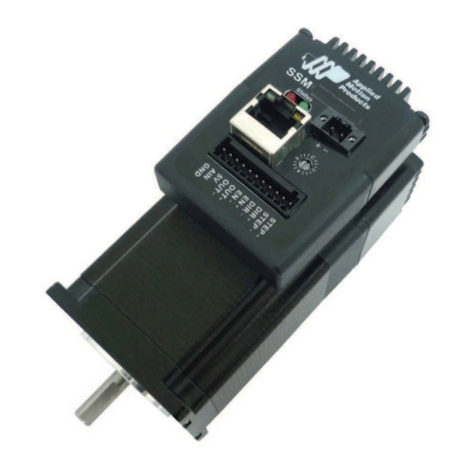
Applied Motion Products
Applied Motion Products SSM23Q Hardware manual
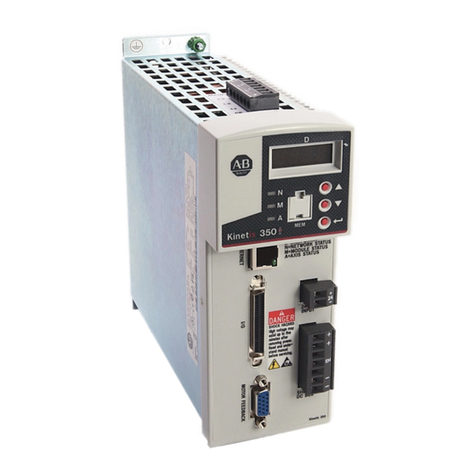
Allen-Bradley
Allen-Bradley 2097-V31PR0 installation instructions
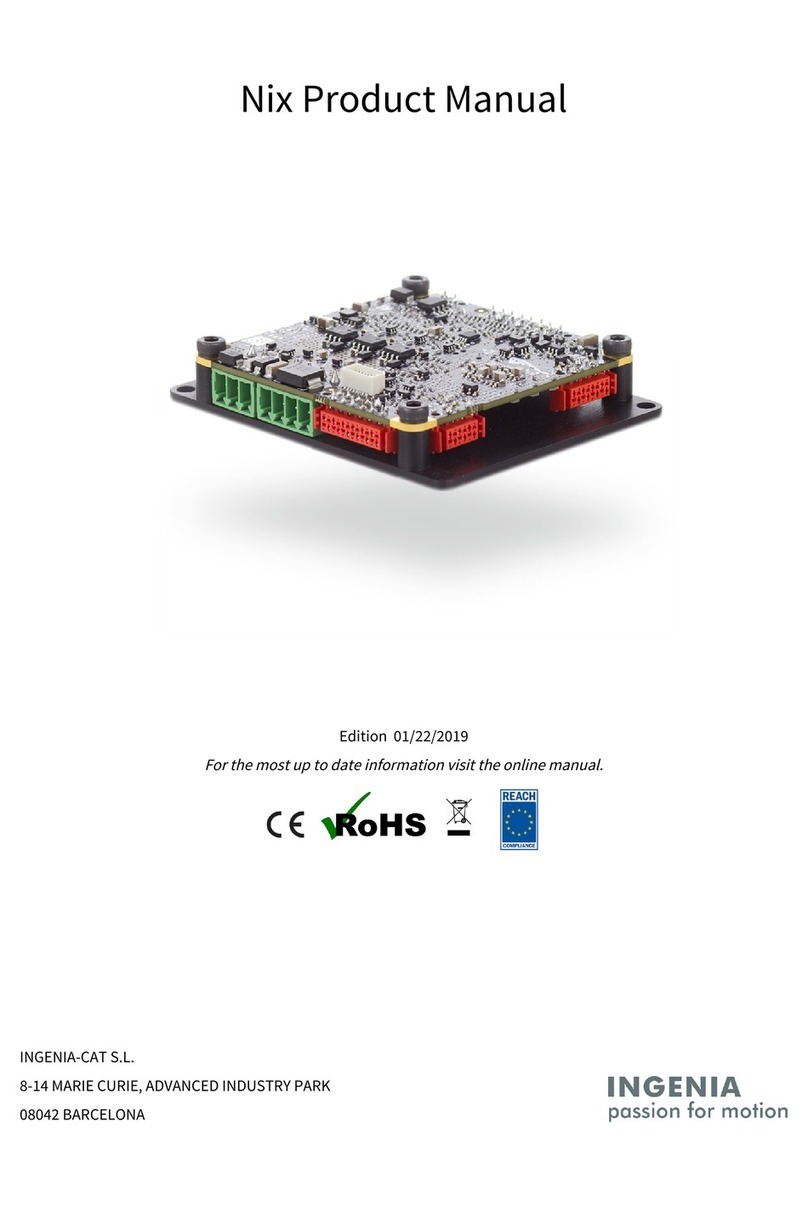
INGENIA
INGENIA Nix series product manual

LICHUAN
LICHUAN MC856 Instruction book
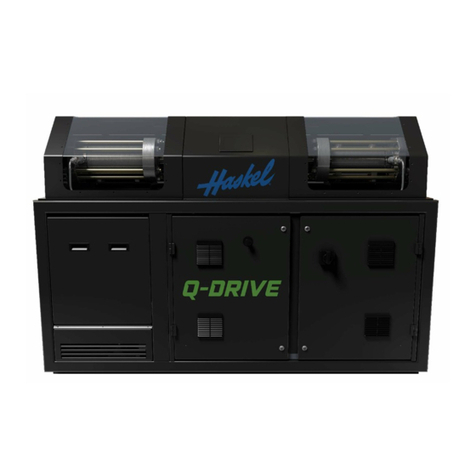
Haskel
Haskel Q-Drive QGD Series Installation, operation and maintenance manual
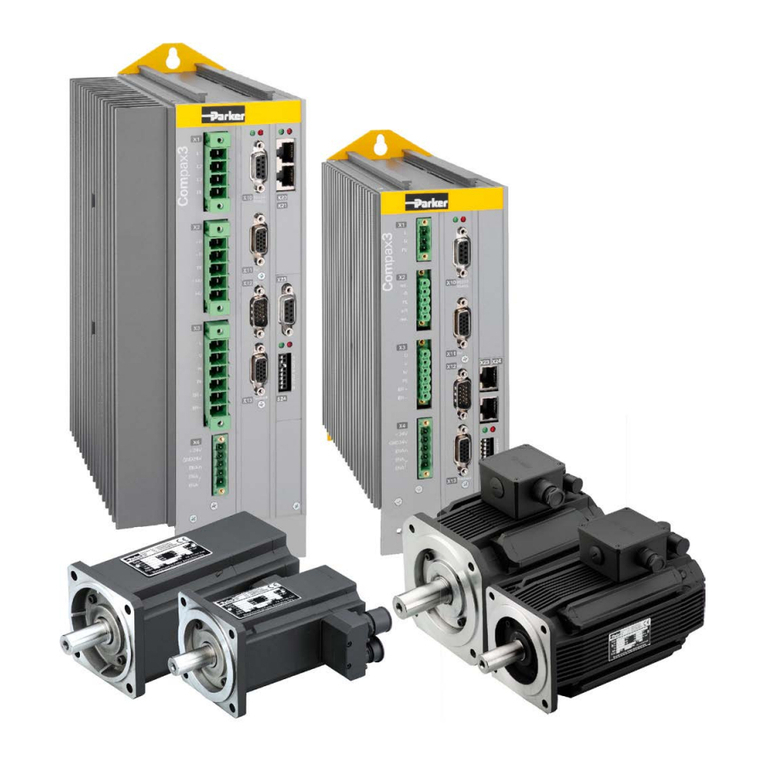
Parker
Parker Compax3S025V2 manual
